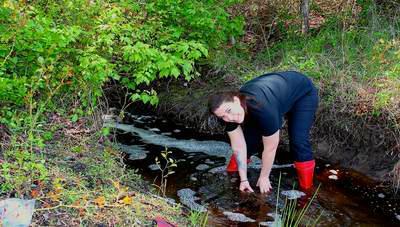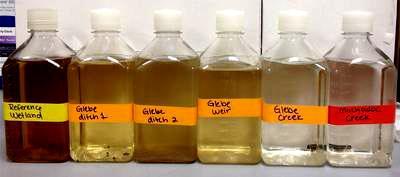
Student-Led Monitoring Programs
Research Activities at the Baliles Center
These projects are under the supervision of Dina M. Leech, PhD, Department of Biological and Environmental Science, Longwood University.
Project #1: Student-centered long-term monitoring of wetland restoration at the Baliles Center

Project Description: The Baliles Center is dedicated to environmental education, and over the last seven years, has hosted several collaborative faculty-student projects aimed at improving water quality and biodiversity in the region. Attention is now directed towards the restoration of wetlands on the property. The objective of this project is to establish a student-led monitoring program to assess the function and benefits of the Farm’s restored wetlands, including data from pre-, concurrent-, and post- wetland construction. Based on the primary literature, it may take 100+ years before a restored wetland begins to function like a natural, undisturbed wetland. Thus, this Longwood student-led program is intended to continue indefinitely, serving as a model of conservation activities in the Chesapeake Bay Watershed and beyond.
Students participating in this project will gain a greater appreciation of the natural world, particularly the biodiversity and ecosystem services (e.g. flood control, water quality regulation) associated with wetland habitats. Students will also gain hands-on research experience that will help them focus their career goals and increase their competitiveness on the environmental job market. Opportunities like these allow students to take what they learned in the classroom and actually put it into practice. From the perspective of the larger community, there is an urgent need for valid scientific research on the impacts that these types of land use changes (i.e. cropland back to wetland) have on the diversity and abundance of plant and animal life as well as nutrient runoff to our coastal waters. Longwood students will therefore provide a valuable, needed dataset to the scientific community. Longwood students will also act as ‘citizen leaders’, educating the larger community about the benefits of wetlands to coastal regions.
Collaborations have been established with Dr. Kirk Havens at the Virginia Institute of Marine Sciences to assist in the development and execution of the monitoring program.
Estimated Student Participation: ~10-20 students per year
Project Timeline: Began Spring 2013 - continuing to collect data indefinitely
Project #2: Changes in Quantity and Quality of Dissolved Organic Matter (DOM) Exported from the Baliles Center, VA before and during Wetland Rest

Project Description: The objective of this research project is to collect data on the quantity and quality of dissolved organic matter (DOM) exported from the Baliles Center throughout the wetland and stream restoration process. Recent studies indicate that the export of labile DOM to coastal streams and rivers often promotes bacterial respiration, potentially leading to low oxygen concentrations downstream. Furthermore, agricultural croplands have been shown to release more labile DOM to streams compared to pristine forests and wetlands. Here, we propose to measure the concentration and chemical character (i.e., labile versus refractory) of DOM leaving the Farm from two opposing streams before and during the restoration of cropland to wetland. Long-term monitoring of DOM will continue indefinitely as the wetland becomes established. Together, results of this study will provide rare and valuable data regarding changes in DOM export during land use changes, which may, in turn, increase our understanding of factors contributing to "dead zones" in the Chesapeake Bay.
Collaborations are being sought with Dr. Elizabeth Canuel at Virginia Institute of Marine Sciences to assist with sample collection and data analysis.
Estimated Student Participation: 1-2 students per year
Project Timeline: Began Spring 2013- continuing to collect data indefinitely
